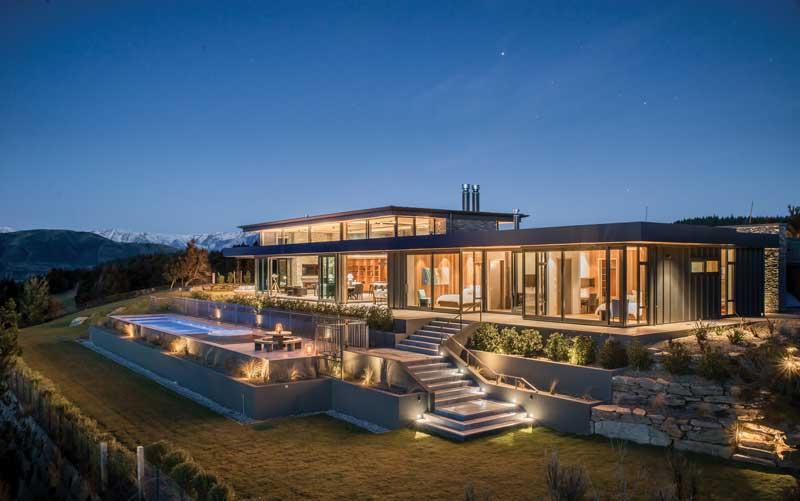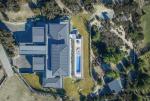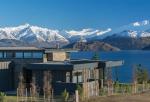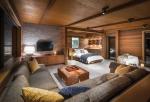The Dacha: Russian meaning for a home away from home

Mt. Gold Place, Wanaka
At the first meeting on site, between the client and architect, they could hardly see the lake view due to the dense vegetation. They had to climb to the roof of the architect’s car to see the potential outlook. It was breathtaking. The brief for design and layout then evolved from a repeated phrase...”don’t let the house get in the way of the view, it’s all about the view.”
A long stacked stone wall, inside and outside, is the spine of the house that divides the service and entry side of the house, that faces the street, from the private and glazed side of the house that faces the lake. At street level, the boat and car garages were split in to two separate forms to break up the expanse of size. The garage areas also contain the mud and laundry rooms, plant room, and wine cellar. Glimpses of the lake can be seen from the slotted windows at the entrance porch that is under the two car drive through Porte Cochere.
Through this formidable stone wall, and Corten steel clad door, the house opens up to the views beyond. The guest wing, at the west end of the home, adjoins a central outdoor room providing separation from the main living area, master suite and study located in the East wing. The goal was to allow views of the lake from every room, not only direct views but views through corners and adjoining rooms to capture more of the panorama. Lots of glass, cantilevers, and large spans were needed.
The Guest Wing contains 4 bedrooms branching off the central lounge. Two luxury double bedrooms with ensuites and walk-in wardrobes face the lake view.
Corner windows widen the views. Mirrors were used in the wardrobes reflecting the lake to give the appearance of looking outside. The other two bedrooms are bunk rooms, but these are no ordinary bunk rooms. They are designed as Japanese style sleeping platforms, where the mattresses are on tatami matts that slide, so beds can be arranged as single or king sizes. Each bunk room can therefore accommodate couples, or groups of individuals. The bathroom arrangement for the bunk room is also unconventional in that the rooms are separated into shower room, vanity room, and WC. With potentially 8 occupants, staying in the bunk rooms, this provided the maximum flexibility in the bathroom arrangement.
The outdoor room faces the lake, yet can be sheltered from the wind by stacking wind screen doors that slide into a cavity when not in use. During the winter, the closing off of the outdoor room, with high clerestory windows and skylights over garden area, creates a greenhouse effect increasing insulation levels in the three, otherwise external, walls of the kitchen, dining, gallery hallway and guest wing.
Verandahs control the solar gain in the summer, let in winter sun, and provide rain shelter over the rooms that open out to the patio overlooking the pool terrace below. The 1.8m wide verandah floats without posts that would obstruct the view. The verandah proportions were carefully designed using computer modelling to calculate the shading effects within rooms during different times of the year. Shade and sunlight simulation movies were emailed to client, in time lapse format, so that they could approve the amount of light and sun planned for each room.
The terrain was a challenge from the outset of planning this project. A small area of relatively flat land was at the top of the site along the drive with no street parking. There was not enough flat area to contain a large scale house and to provide ample space for car, boat and guest parking and turning. The main part of the house had to be built over the steeply sloping terrain. This meant parts of the north facing patio would be up to 3 meters above the existing ground level. With the brief mantra, “it’s all about the view”, in mind a balustrade free solution was needed. To complicate the design the clients asked for a pool. A series of cleverly designed stepped planter boxes provide for safety and allowed the pool fencing below to be screened from the house. The planter elevation eliminated the need for fencing from the lake view side of the pool.
The clients wanted to provide a journey through the site’s rough terrain and indigenous stands of Kanuka. A schist patio was created on the outlook knob, which provides 360 degree views of the surrounding mountains and lake. On the downhill slope the clients wanted to build a hut as a retreat for their teenage daughters. During construction the building was named “The Banya”, meaning a spa or retreat house in Russian. The rustic timber lined internal walls make the space feel warm and inviting. The building form is designed to tuck in to the hillside, blending with the landscape.
Materials
The lines from the interior and exterior were blurred, as materials such as the patio tiles, stonework, metalwork, cedar, aluminium composite panelling, were all consistent.
The clients loved the look of natural cedar exterior cladding but the on going maintenance was off-putting. The solution was the use of cedar cladding on many of the ceilings and interior walls. The ambience of the natural timber gives a relaxing, warm, holiday feel without the pressure of spending free time staining sun beaten weatherboards. Gaboon plywood and cedar T&G is used for exterior soffit linings.
There were strict resource consent conditions that meant that the exterior cladding colour had to be dark and recessive tones. This was be easily achievable with a metal cladding solution.
The cladding for the exterior became metal, stone, and lots of glass.
Metalcraft Espan roof and wall cladding was selected for the look of its standing seam profile and its hidden clip fixings without penetrations. The Thunder Grey colour from the COLORSTEEL® Maxx® colour chart complied with consent conditions. The Espan product was used on all the main 5 degree pitched roofs, including the 3 degree roofs over the garages that were hidden behind parapet walls. Membrane roofs were used for the 2 degree pitched roofs over the Porte Cochere, hallway link, and verandahs.
The upper roof over the living area and outdoor room, supported on a series of internally positioned steel portals, appears to float between the two massive stone chimneys. Metalcraft provided architectural spouting in a custom made wide angular profile that enhanced this floating effect. The spouting was fixed to fascias made of aluminium composite panels. The same aluminium composite panels were also used on the interior to line the inside faces of the skylights.
What you don’t see
The most exciting parts of this project, are the items that you don’t see at all. They are deep in the ground, under the slab, and hidden behind the linings. Controlling energy consumption, harvesting energy from the site and utilising passive design principles. These were all driving forces in decisions of how the house would be constructed.
Eliska says, “I’m particularly proud of the building team, that were not phased by the scope and intricacy of this project and the many challenges of the site conditions.”
Substantial earthwork retaining walls were constructed to stabilise level lawn areas that house geothermal heating fields. The underfloor heating for the house, the towel radiators, the hot water cylinder, and even the 10 pair ski boot drying rack are all heated by geothermal energy.
To preserve this harvested heat the house was designed to minimize heat loss. The floor slabs were constructed with double thickness, where the insulation is sandwiched between the structural slab and the topping slab, to eliminate thermal bridging through foundation walls.
Steel posts, which are a good conductor, were exposed and brought to the warm interior part of the house, rather than having them positioned in walls to become cold bridges. Aluminium joinery had low emission glazing and thermally broken frames.
The external walls have Metalcraft cladding with proprietary cavibats on a rigid plywood air barrier fixed to 140mm framing. The walls are lined with Proclima Intello vapour check and airtightness membrane, with an additional layer of 45mm battens with insulation laid to bridge the studs and provide fixing for the interior wall linings. The 45mm battens also provide a service cavity, so that the main exterior insulation could remain intact.
Houses of this scale have to accommodate a large amount of cabling and ducting. It was important to maintain maximum levels of ceiling insulation, and not allow heat loss by penetrating in to this roof space. A Proclima Intello vapour check and airtightness membrane was attached, to the underside of the roof framing, with all services running below this layer. Services were methodically planned to be contained within dropped ceiling areas designed over the hallways and bathrooms and cupboards. The architects design makes use of these bulkheads to take services to areas that didn’t have dropped ceilings effectively making them design features.
The final phase of this project will be the installation of future photo voltaic panels for generating electricity. Conduit has been put into the roof space and left ready for a installation. The Metalcraft Espan roofing profile allows for the panels to simply clip to the standing seams without additional penetrations to the roof.
The result is a future proofed, minimal maintenance, home that balances the energy resources needed to maintain comfort.







